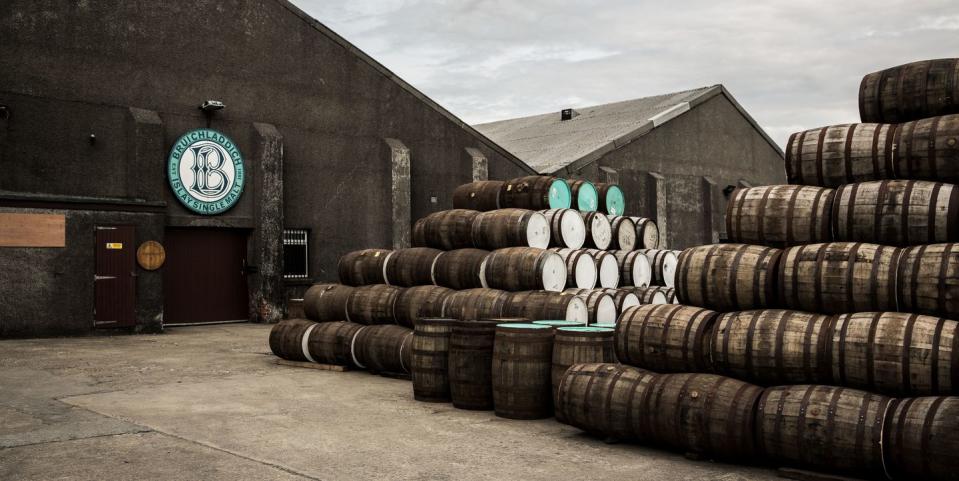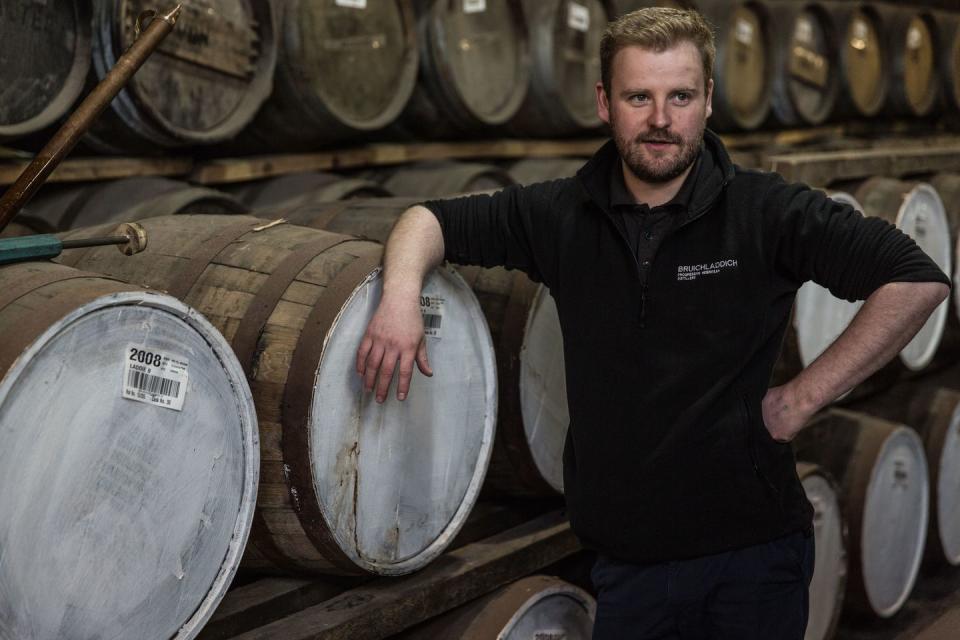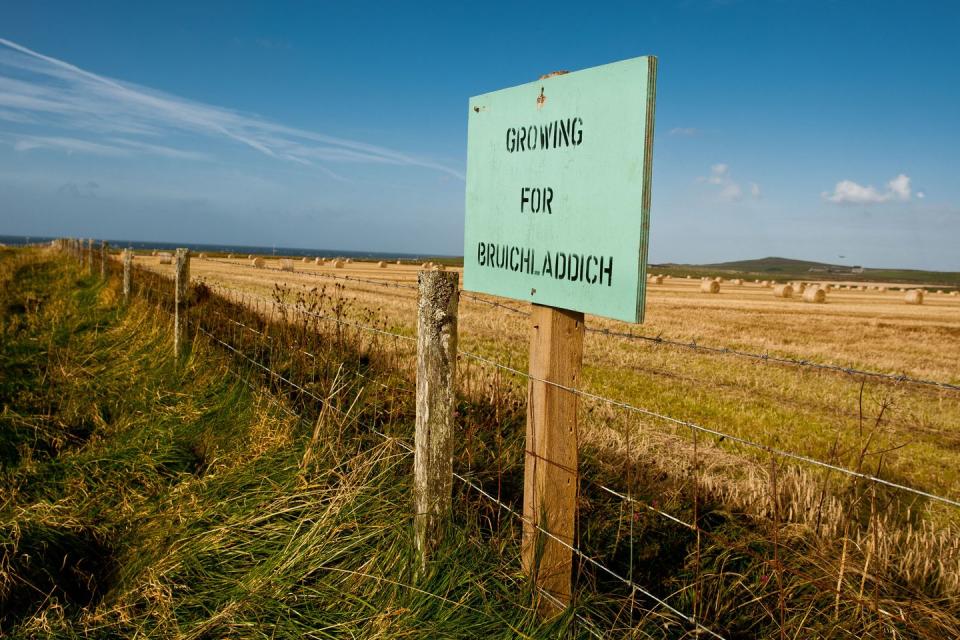Bruichladdich Wants to Turn Your Whisky Green

Talking about terroirs, varietals and sustainable farming usually places you firmly in vinous territory – the wine world revolves around soil types and climates and which grapes can be planted where; indeed, which grapes are better than others (though let’s not open that can of worms – we don’t want to turn into Paul Giamatti in Sideways, after all). But have you ever considered what type of barley has gone into your whisky? Hell, can you even name any different kinds of barley? The Bruichladdich distillery on the Hebridean island of Islay would like you to, as part of a dogged commitment to sustainability that transcends voguish buzzwords and seeks to change what we know and understand about the whisky we drink, as well as decarbonising how they produce that whisky by 2025. Think of it like the natural wine movement, only with a kick.
First order of business: Islay is pronounced ‘eye-lah’ and Bruichladdich is pronounced ‘brook-laddie’. The 620 square kilometre island is situated off the west coast of Scotland, the most southerly of the Inner Hebrides, and can be reached by plane (a mere 45 minutes from Glasgow airport – you’re no sooner up than you’re down) or by ferry (a longer but incredibly scenic route). Its whisky-making history goes back hundreds of years and Islay boasts a worldwide reputation for those big, bold, peaty styles of single malt known to knock your socks off (think Ardbeg, Lagavulin or Laphroaig). This is down to the peat bogs that dominate the landscape: when peat is burned as a fuel during the malting process (whereby steeped grains of barley are dried out, ready to be mixed with water in a mash tun and subsequently fermented with yeast, then distilled), it can impart an inimitably smoky flavour. However, contrary to common perception, since other fuels can be used for malting, Islay whiskies do not necessarily have to display this Marmite-esque quality.
Bruichladdich’s whiskies don’t, for example. Or at least, not those in its eponymous core range. You only have to look at its bright turquoise bottles to see that this is a distillery unafraid of challenging preconceived notions about whisky, and since being resurrected in 2001, it has railed against what it calls the “staid whisky world.” Founded in 1881, Bruichladdich encompasses its range of clean-tasting, unpeated single malts in addition to a series of “heavily peated” ones (known as ‘Port Charlotte’), “super-heavily peated” ones (‘Octomore’) and The Botanist gin, which came along in 2010 – an example of what else Islay’s flora can create. Production wasn’t always so prolific, and Bruichladdich’s rather chequered twentieth century saw it repeatedly change hands and get mothballed not once but four times. It came out of its last period of hibernation in 2001 after being acquired by two London wine merchants and a small group of private investors.

The wine association is an important one as the new owners, Mark Reynier and Simon Coughlin were, furthermore, Burgundy fanatics, an area of France where location is king – vineyards are pinpointed with excruciating exactitude and ranked by geological superiority. Creating a liquid that truly represents where it came from is a primary theme and this mentality is key to Bruichladdich’s contemporary incarnation.
“Their attitude was quite unlike anything in the whisky world at that time,” head distiller and native Ileach Adam Hannett tells me. “Where companies had become conglomerates as a means to survive, flavour diversity and nuance had been stripped out in order to produce a consistent, standardised product. Distilleries were adding caramel colouring and chill-filtering it – stripping out the natural fats – in order to create homogeneity that was easily recognisable and easily marketed globally.
Reynier and Coughlin wanted to do something different, so they looked to the wine world. "They reconnected to the ingredients including what, how, who and where the barley was grown," says Hannett. "They celebrated variety in every bottling and refused to make cheap or efficient decisions such as outsourcing, that would shift the benefits of whisky-making away from our rural, island economy.”
Winemakers who choose to practice in an organic or biodynamic fashion may seek certification, permitting them to declare their products thus on the bottle in a way that drinkers may be familiar with. Spirits haven’t quite made it to such general understanding yet. “For spirits, we seem to be a little further disconnected from that sustainability consciousness and awareness,” says Hannett. “Even beyond agriculture, which is where our industry desperately needs to pay more attention, the wine industry is making progress that we can only dream of… there’s no demand for outer packaging, retailers are conscious of the weight of the glass, consumers are more educated about inputs, natural wines, even regionality and what it stands for. It’s all very promising though.”

For its part, Bruichladdich has joined the movement seeking greater clarity on just what is in the whisky you buy, and every bottle of their ‘Classic Laddie’ now carries a code that, when entered into a web page, will list every cask that contributed to it and in what proportion. It’s a neat sidestep around EU regulations that prohibit certain information from being divulged, meaning that, for each composite bit of liquid, you can know the type of barley used, where it was grown, when it was distilled (if allowed) and what kinds of barrels it was matured in.
All of that barley now comes from Scotland (not a given, even with Scotch), with 42 per cent from Islay itself, though that number is rising. The team works closely with its farmers, ensuring constant crop rotations to maintain healthy, fertile soils, and experimenting with different varietals. It’s not always successful – the first attempts with the ancient bere grain broke the mash tun – but it's important for finding what suits the soil and being able to cross-breed with conventional varieties, not to mention varying the styles of whisky available: bere barley, for instance, imbues the liquid with a richer mouth-feel and deeper flavour profile.
Last May, such effort was rewarded when Bruichladdich became the first Scottish malt whisky to achieve B Corporation status, an increasingly revered international certification that assesses a company’s social and environmental impact on all levels, big and small, using a points-based system. A relatively new concept, it only opened up to the UK in 2015 and there are currently around 3,500 certified companies worldwide, including Patagonia, Ben & Jerry’s, Aesop, The Body Shop, Innocent Drinks, The Big Issue and the Jamie Oliver Group.
“Being B Corp certified hasn’t changed too much of what I do at the moment,” says Hannett, “which is a sign we’ve always been on the right path. We see B Corp as a stamp of approval for the work we’ve been carrying out for the past 20 years.”
That work includes incremental changes like reducing plastic usage, to punchier ambitions like making production carbon neutral by 2025. Already, the waste water from heating the stills in the distillery is being reused to heat the offices, bottling hall and visitor centre, electricity is now from 100 per cent renewable sources within the UK, and plans are afoot to build their own maltings by 2023; whereas most barley is currently malted for them in Inverness, this will bring the entire production process in-house (they already do their own bottling and maturing), thus reducing transportation emissions and giving them ever greater control. Options are already being considered for peatland restoration and carbon offsetting for when the time comes.

Reaching net zero for distillation will be trickier, not least because of the isolated location that means there’s no existing infrastructure to tap into for alternative energy. The biggest direct emissions come from the distillery itself, in particular, by heating the water that generates steam for the stills. Fuel oil is currently used for this but other, greener sources of energy are being investigated, including wind, solar, electrification, biomass and fuel switching. The most exciting is hydrogen, with a project named ‘HyLaddie’ underway to install a Deuterium Dynamic Combustion Chamber, which would turn oxygen and hydrogen into high temperature steam whilst only producing water – no carbon dioxide, sulphur oxides or nitrous oxides. Bruichladdich’s partners, Protium Solutions, were awarded £70,000 of government money for it earlier this year, and will be submitting their findings in May in a bid for further funding.
Another option is tidal, and Edinburgh-based energy firm Nova Innovation announced in February that it would be installing underwater turbines between the islands of Islay and Jura. This ‘Oran na Mara’ project could be running by 2022 and would generate 3 megawatts of energy for all nine distilleries on Islay.
Crucially, any new sources of energy must be compatible with Bruichladdich’s Victorian equipment (lovingly referred to as a “museum” by staff, it poses a challenge in itself compared to higher-tech apparatus). Since the issue is powering the stills, said stills themselves will remain intact and, consequently, so will the flavour of the whiskies. “For two decades now, Bruichladdich has pursued flavour and nuance in single malt whisky,” Hannett assures me. “We have no intention of compromising this ethos as we make our business more sustainable.”
It’s an exciting time for Islay, which has been enjoying something of a renaissance in recent years: 2019 saw the opening of its first new distillery since 2005, Ardnahoe, and planning permission has finally been approved for another, from Elixir Distillers (owners of The Whisky Exchange – a great online store), nearly three years after submitting its original application. The ‘lost’ distillery of Port Ellen, empty since 1983, is being revived by drinks giants Diageo with production due to begin this year. Elsewhere, there has been a slick makeover at The Machrie Hotel and Golf Links, and a new craft rum distillery has just been announced, causing much excitement.
Islay has long been a mecca for whisky lovers, but as new life (and fresh air) is breathed into the island, an approach like Bruichladdich’s will be critical. “Our people, the wider Islay community and the environment are at the heart of every decision we make,” says Hannett. “It’s challenging the small stuff as well as the big picture that will help us make a positive impact and leave behind a proud legacy for future island generations.”
Like this article? Sign up to our newsletter to get more articles like this delivered straight to your inbox
Need some positivity right now? Subscribe to Esquire now for a hit of style, fitness, culture and advice from the experts
You Might Also Like

 Yahoo Movies
Yahoo Movies 